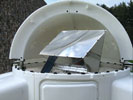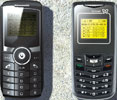
South Africa
Reunert has released unaudited results for the six months ended 31 March 2008. Revenues increased by 9% to R5,1 billion, while operating profit on a comparable basis grew by 6% to R643 million. Normalised headline earnings per share increased by 7% to 277,5 cents per share and an interim cash dividend of 78 cents per share, 7% up on last year, was declared. Cash on hand was R294 million at the end of March.
Concilium Technologies has been appointed as the first South African distributor for Gigamon Systems, provider of the GigaVUE family of out-of-band data access switches. Headquartered in Silicon Valley in the US, the company's GigaVUE product is a second-generation switch which allows multiple tools to share a single view of the network. Essentially, the GigaVUE switch delivers copies to network traffic monitoring tools that encompass security, troubleshooting, compliance and applications.
Meissner recently supplied over 500 uninterruptible power supplies (UPSs) to Sun International resorts situated in South Africa, Namibia and Botswana, including among others Sun City, The Carousel, Carnival City and the Marula Sun. The 1,5 kVA UPSs were rolled out specifically for Sun International's slot machines.
MTN is introducing efficient energy saving solutions to overcome the current electricity supply problems. The company is using light fittings with sensor technology designed for automatic dimming regulated by the amount of daylight that is present at any particular time. When there is no movement detected the lights will automatically turn off. The organisation also recently embarked on an awareness drive to involve staff in participating and sharing ideas on energy consumption with some of these initiatives being in partnership with Eskom.
Voice over Internet Protocol (VoIP), which allows Internet users to make phone calls to each other at no cost, is finally taking off among South African businesses, four years after it became legal to use it outside company networks. This is the key finding of a study released by World Wide Worx. At the end of 2007, half of all corporations were making use of VoIP, and that usage level is expected to rise to 64% in 2008. Most of these companies are using it within the context of least-cost routing (LCR), which enables any phone call made from inside the company to be routed via the most cost-effective route. Among SMEs, however, deployment of VoIP is still rather modest, despite LCR having been adopted at almost a similar rate as corporate adoption. The use of VoIP among SMEs for business purposes rose from 9% in 2006 to 18% in 2007, after rising from 2% in 2004 (before legalisation) to 4% in 2005. This represents an effective doubling in each of the years in which it has been deployed among SMEs.
Overseas
Business
Mentor Graphics announced first quarter fiscal 2009 revenue of $179,2 million, a decrease of 7,9% from $194,5 million in the same period of 2008. Non-GAAP earnings per share were a loss of $0,10, compared to earnings per share of $0,12 in the like period last year. On a GAAP basis, earnings per share were a loss of $0,30, including significant special charges driven by cost control activities in the quarter.
Companies
Texas Instruments has acquired Ireland-based Commergy Technologies, a power supply reference design provider that specialises in energy efficient and compact architectures. The acquisition allows TI to broaden its focus on improving energy efficiency in today's end-equipment designs, especially in the areas of AC adapters and high-power-density computing and server systems. The terms of the acquisition were not announced.
Mentor Graphics has acquired the assets of Ponte Solutions, a developer of model-based design for manufacturing (DFM) solutions that analyse, predict, and reduce the impact of process variability during the manufacture and design of semiconductors. Terms of the transaction were not disclosed.
Ixys announced that it has made a proposal to ZiLOG's board of directors to acquire all the outstanding shares of ZiLOG common stock for a per-share consideration of $4,50, to be paid in cash and stock. Despite recruiting a new sales and management team, ZiLOG is still considered a company whose sales performance lags behind its undeniable technical achievements. It is expected that ZiLOG's microcontroller semiconductor devices would strongly complement Ixys' IC business and that such a merger would extend ZiLOG's reach beyond Europe and onto the global stage.
Industry
The worldwide electronic manufacturing services (EMS) industry grew at an annual rate of 17% in 2007, generating $268,1 billion in revenues, according to new research from IDC. While the original design manufacturer (ODM) sector continued to grow at the higher rate of 23% in 2007, the EMS sector still accounted for more than 60% of the industry. The two largest product segments remained computers and consumer devices, generating 36% and 29% of the EMS industry revenue respectively in 2007. The regional revenue mix was also fairly stable in 2007 due to the realignments US EMS firms undertook to shift their geographic footprints offshore. Foxconn maintained its lead in the market, with 16% of all industry revenues, growing by 46% from 2006. Flextronics grew to 12% market share as it acquired Solectron. Quanta enjoyed the strongest annual growth of 57%, based on its success in the notebook segment, winning business from Apple and Dell.
IEEE is creating standards to facilitate the movement of nanotechnology innovations from a research to a market environment and to establish fundamental nanotechnology platforms that support accelerated growth. These standards address critical commercialisation issues, such as nanoelectronics device design and characterisation, as well as quality and yield in manufacturing.
The market prospects for communications test and measurement equipment designed for manufacturers is favourable as the telecommunications market experiences a tremendous increase in the deployment of voice, video and data (triple play) over broadband. This places considerable pressure on network equipment manufacturers (NEMs) to prove the quality of their network equipment for the IP video and VoIP aspects of triple play. According to research by Frost & Sullivan, the worldwide market for communications test equipment for manufacturers earned revenues of $1,57 billion in 2007, which is estimated to reach $3,33 billion in 2014.
The RapidIO Trade Association, dedicated to driving the development and adoption of the RapidIO interconnect standard, has announced seven new members: GE Fanuc Intelligent Platforms, HDL Design House, Motorola, Nortel, Qualcomm, RMI Corporation and Wintegra. The association also unveiled its new technology roadmap that provides details about RapidIO Specification Rev. 2.0, and previews the development of Specification Rev. 3.0, which will continue to be defined collaboratively over the next 24 months. While the current standard (Specification Rev. 1.3) will continue to dominate embedded applications for the foreseeable future, silicon using the latest revision is expected to debut in 2009.
Technology
Researchers from the University of Southern California, Purdue University and Northwestern University have developed an active matrix display based on OLED (organic light emitting diode) technology and employing nanowire transistors. The prototype display uses indium-oxide-nanowire transistors, indium-tin-oxide electrodes, and plastic capacitors to form an array of OLEDs, which provide better flexibility and transparency than silicon components. These properties support applications such as heads-up displays and small displays for portable consumer devices.
MIPS Technologies has claimed that its Hi-Fi Audio Codec IP platform has achieved the world's lowest known power consumption for Hi-Fi audio playback. Already silicon-proven in multiple processes and foundries, including TSMC 90 nm, it is now also silicon-proven with first-pass success in Fujitsu 90 nm. The new audio codec IP achieves an impressive 100 dB dynamic range and -93 dB THD while consuming only 7,8 mW power when playing back through stereo line outputs at 48 kHz. This is the lowest known power consumption for above-96 dB rated performance. This platform maximises battery life in next-generation consumer electronic devices with audio functionality, including CDs, mini-disks, multiformat and DVD players and recorders, PMPs, PDAs and GPS handheld devices, as well as cellular and smart phones.
Researchers have developed magnetic 'nanoworm' particles to aid in the detection of tumours. The nanoworms are expected to allow earlier detection of cancer by circulating in a person's bloodstream and homing in on tumours to enhance MRI (magnetic resonance imaging) scans, which are often not intense enough to detect small tumours. The nanoworm's shape and chemical composition are precisely tailored to fool a patient's immune system into believing that it is not a threat.
Scientists at the Leibniz Institute in Germany have developed a new method of generating hydrogen that could make fuel cell technology more practical as a method of powering portable electronic devices such as cellphones and laptops. The system converts formic acid, which is a common preservative and antibacterial agent, into hydrogen gas at low temperatures. The major drawback of the technology is that formic acid actually yields less hydrogen than methanol, for example. This means that 1 kilogram of formic acid produces only 1,45 kilowatt-hours of energy, compared to 4,19 kilowatt-hours from methanol.
IBM researchers have developed a method of cooling photovoltaic cells that will allow for more concentrated focus of light and therefore more efficient energy generation. The technology utilises water cooling and adapts a material which is used to cool computer chips by improving the transfer of heat between the chip and its heatsink. The result is being able to focus 2300 times the sun's natural energy onto a chip measuring 1 square centimetre. This energy concentration would normally heat the chip up to 1500°C - hot enough to melt steel - while this cooling system maintains the heat down to 85°C.

A team of scientists at Harvard University has made a breakthrough in the development of terahertz lasers, devices that promise applications in sensitive chemical detection, ultra-fast data transmission and the ability to penetrate walls and clothing. The new development not only shrinks the laser down to the size of a fingernail, but allows it to operate at room temperature, without the need for liquid nitrogen cooling. The 5 THz device uses a special light-mixing process to combine two different wavelengths of infra-red light, in a specially designed semiconductor region much smaller than usually required. The laser currently emits only a microwatt of power, while at least a milliwatt would be required to make it a practical solution, but there are plans to adapt the design of the chip's emitting surface, which could boost output power by an order of magnitude.
Qualcomm MEMS Technologies has unveiled the first colour displays in its Mirasol range. These MEMS (micro electro mechanical systems) displays offer advantages over LED and OLED variants in that they consume less power and are readable in outdoor ambient light. These advantages make them ideal for applications such as cellphones, where Qualcomm has already won design contracts with previous generation displays, despite being monochrome. The new line of displays includes 3,3", 2,1" and 0,9" versions, with the latter consuming just 9 mW.


© Technews Publishing (Pty) Ltd | All Rights Reserved